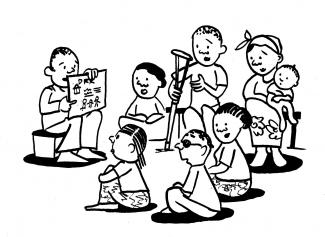
Means of communication need to be adapted so that entire communities, including persons with disabilities can receive, understand and act upon important information.
Always remember to use plain, positive language on gender, disability and minority groups when making campaigns, providing information, in meetings, when making advertisements, or designing promotional materials.
General tips on inclusive communication:
-
Use simple, clear and unambiguous speech and body language and gestures that support the spoken word
-
Use a variety of communication tools, which support the understanding of the message: drawing, pictures, gestures, theatre or role plays
-
Talk to children, persons with disabilities or older persons directly, and not to their assistants or caregivers for those who use this support.
-
Create opportunities, relationships and environments through your work, that make individuals want to communicate.
- Check for understanding of key information.
- Adapt your communication according to the needs of the audience, by allowing enough time for people to process information and ask follow-up questions, or for repeating information.
- Involve community members with a variety of backgrounds, including persons with disabilities, in developing communication messages.
Specific arrangements depending on the type of difficultiy people face:
-
Provide sign language interpretation or communicate using pen and paper for deaf or hard of hearing persons;
- When communicating with persons with a mental health condition or in distress, be mindful of body language, communicate clearly but softly. Use an un-threatening tone and volume and actively listen, as the person could be experiencing adversity and related distress;
-
Read out written material for people with difficulties reading or who are blind;
- Offer opportunities for one-on-one dialogues, in addition to group communications, for persons with intellectual or psychosocial disabilities.
- Use interactive approaches for those with intellectual disabilities and communication needs.
For further tips on inclusive communication during disaster, see: Communication in disaster.